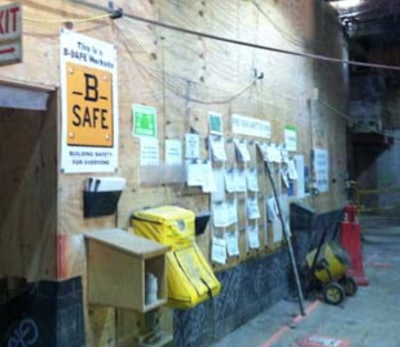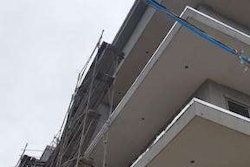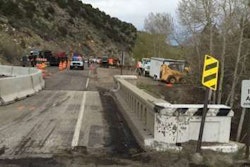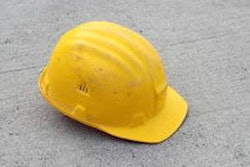 Workers at a Boston jobsite where B-SAFE has been implemented gather for one of the program’s safety talks.
Workers at a Boston jobsite where B-SAFE has been implemented gather for one of the program’s safety talks.A new construction safety program is ignoring a certain saying about free lunches in order to increase awareness about the specific working conditions on individual jobsites.
Dubbed B-SAFE (Building Safety For Everyone), the program was developed over the last few years by Harvard student Emily Sparer who graduated earlier this month with a doctorate in occupational safety. The program was successfully implemented on various Boston jobsites with at least one company looking at installing the program across all of its jobsites.
 A wall displaying safety data gathered as part of the program.
A wall displaying safety data gathered as part of the program.Sparer began working on the program in order to bring workers a bit more stability while working on jobsites that can undergo pretty extreme day-to-day changes.
“What struck me about construction sites is how dynamic and fluid they are,” she explained in a release from Harvard’s T.H. Chan School of Public Health. “You can be on a site one day talking to people, and come back the next day to find a giant hole or a wall in the spot where you were standing. Safety systems need to be designed for an environment that is constantly evolving.”
Construction accounted for the most workplace deaths in 2013, according to the latest data available from the Bureau of Labor Statistics. That year, 828 construction workers died, the highest number of deaths seen in the industry since 2009.
Sparer said the problem on most jobsites isn’t a lack of attention to safety, it’s that the knowledge and data gathered isn’t being disseminated widely enough among workers. While inspections and daily safety checks are fairly common on many jobsites, Sparer said she wanted to encourage the managers doing these checks to begin giving reports to the foremen of each crew working at the site.
In her testing of the program, Sparer provided a weekly narrative report on safety conditions to foremen who then shared the information with their workers. She said the reports increased discussion over working conditions and found that the program gave many workers their first positive feedback for paying attention to safety.
You can see a full breakdown on the program’s effectiveness on four jobsites versus four jobsites without the program here.
How it works
So what does the program look like when implemented on a site?
According to the B-SAFE website, a kick-off program is held on the site to explain the program before the site establishes a threshold site safety score. The score is calculated by the program’s manager at the site based on safety scores at sites of similar size.
Once the score is established, the B-Safe manager begins making weekly site safety assessments. These assessments include all trades and tasks on the site and are done using Predictive Solutions software. (The B-SAFE site says the program can be run using other software if preferred.)
Once an assessment is completed, scores are calculated for each trade, task and sub-contractor on the site and are distributed to all safety mangers and foremen within 24 hours. The scores are then displayed on posters around the site in order to encourage a bit of friendly competition between the crews.
Should the site’s cumulative monthly score exceed the score established at the beginning of the program, all workers on the site are treated to a free lunch or another reward of the B-Safe program manager’s choosing.
Next steps
If a contractor or firm is interested in trying out B-SAFE on their jobsites, the program’s website includes a complete breakdown on how to introduce the program to everyone involved as well as an explanation of all the required roles. The site also houses more than a dozen downloads to help get you started including flyers, checklists, templates and more.











